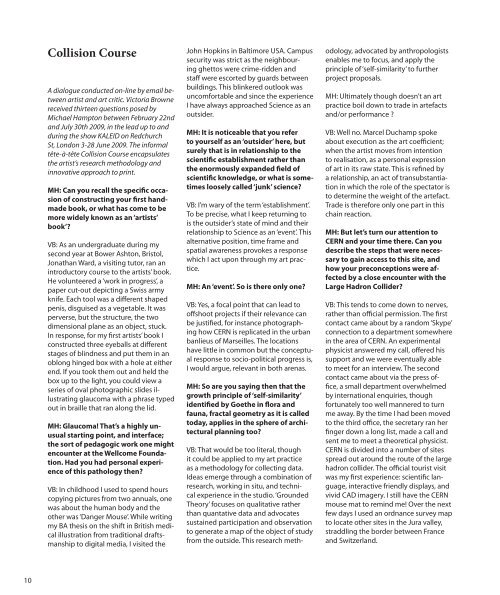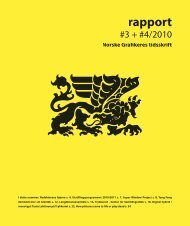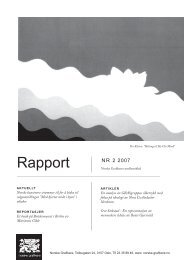Create successful ePaper yourself
Turn your PDF publications into a flip-book with our unique Google optimized e-Paper software.
Collision CourseA dialogue conducted on-line by email betweenartist and art critic. Victoria Brownereceived thirteen questions posed byMichael Hampton between February 22ndand July 30th 2009, in the lead up to andduring the show KALEID on RedchurchSt, London 3-28 June 2009. The informaltête-à-tête Collision Course encapsulatesthe artist’s research methodology andinnovative approach to print.MH: Can you recall the specific occasionof constructing your first handmadebook, or what has come to bemore widely known as an ‘artists’book’?VB: As an undergraduate during mysecond year at Bower Ashton, Bristol,Jonathan Ward, a visiting tutor, ran anintroductory course to the artists’ book.He volunteered a ‘work in progress’, apaper cut-out depicting a Swiss armyknife. Each tool was a different shapedpenis, disguised as a vegetable. It wasperverse, but the structure, the twodimensional plane as an object, stuck.In response, for my first artists’ book Iconstructed three eyeballs at differentstages of blindness and put them in anoblong hinged box with a hole at eitherend. If you took them out and held thebox up to the light, you could view aseries of oval photographic slides illustratingglaucoma with a phrase typedout in braille that ran along the lid.MH: Glaucoma! That’s a highly unusualstarting point, and interface;the sort of pedagogic work one mightencounter at the Wellcome Foundation.Had you had personal experienceof this pathology then?VB: In childhood I used to spend hourscopying pictures from two annuals, onewas about the human body and theother was ‘Danger Mouse’. While writingmy BA thesis on the shift in British medicalillustration from traditional draftsmanshipto digital media, I visited theJohn Hopkins in Baltimore USA. Campussecurity was strict as the neighbouringghettos were crime-ridden andstaff were escorted by guards betweenbuildings. This blinkered outlook wasuncomfortable and since the experienceI have always approached Science as anoutsider.MH: It is noticeable that you referto yourself as an ‘outsider’ here, butsurely that is in relationship to thescientific establishment rather thanthe enormously expanded field ofscientific knowledge, or what is sometimesloosely called ‘junk’ science?VB: I’m wary of the term ‘establishment’.To be precise, what I keep returning tois the outsider’s state of mind and theirrelationship to Science as an ‘event’. Thisalternative position, time frame andspatial awareness provokes a responsewhich I act upon through my art practice.MH: An ‘event’. So is there only one?VB: Yes, a focal point that can lead tooffshoot projects if their relevance canbe justified, for instance photographinghow CERN is replicated in the urbanbanlieus of Marseilles. The locationshave little in common but the conceptualresponse to socio-political progress is,I would argue, relevant in both arenas.MH: So are you saying then that thegrowth principle of ‘self-similarity’identified by Goethe in flora andfauna, fractal geometry as it is calledtoday, applies in the sphere of architecturalplanning too?VB: That would be too literal, thoughit could be applied to my art practiceas a methodology for collecting data.Ideas emerge through a combination ofresearch, working in situ, and technicalexperience in the studio. ‘GroundedTheory’ focuses on qualitative ratherthan quantative data and advocatessustained participation and observationto generate a map of the object of studyfrom the outside. This research methodology,advocated by anthropologistsenables me to focus, and apply theprinciple of ‘self-similarity’ to furtherproject proposals.MH: Ultimately though doesn’t an artpractice boil down to trade in artefactsand/or performance ?VB: Well no. Marcel Duchamp spokeabout execution as the art coefficient;when the artist moves from intentionto realisation, as a personal expressionof art in its raw state. This is refined bya relationship, an act of transubstantiationin which the role of the spectator isto determine the weight of the artefact.Trade is therefore only one part in thischain reaction.MH: But let’s turn our attention toCERN and your time there. Can youdescribe the steps that were necessaryto gain access to this site, andhow your preconceptions were affectedby a close encounter with theLarge Hadron Collider?VB: This tends to come down to nerves,rather than official permission. The firstcontact came about by a random ‘Skype’connection to a department somewherein the area of CERN. An experimentalphysicist answered my call, offered hissupport and we were eventually ableto meet for an interview. The secondcontact came about via the press office,a small department overwhelmedby international enquiries, thoughfortunately too well mannered to turnme away. By the time I had been movedto the third office, the secretary ran herfinger down a long list, made a call andsent me to meet a theoretical physicist.CERN is divided into a number of sitesspread out around the route of the largehadron collider. The official tourist visitwas my first experience: scientific language,interactive friendly displays, andvivid CAD imagery. I still have the CERNmouse mat to remind me! Over the nextfew days I used an ordnance survey mapto locate other sites in the Jura valley,straddling the border between Franceand Switzerland.So how to conceive a supercollider burieddeep underground, firing protonsclose to the speed of light? The LHC wasas elusive as the Higgs boson. The onlygive away was the distinct architecture,often discretely hidden behind trees,set against incessant buzzing from overheadelectric pylons. CERN consumes200 megawatts of electricity, equivalentto half of the consumption of GenevaCity. Saving the planet appears far fromthe minds of particle physicists.MH: Elsewhere you have alluded tothis exotic realm of ‘Superstrings’or ‘M-theory’ being investigated atCERN as “a new art of barbarism”which is an intriguing remark initself. Now, to fall back on that ratherhackneyed category ‘the sublime’,would you say that breakthroughs inthe understanding and descriptionof the physical universe, well belowthe threshold of the naked eye, signala re-inscription of ‘the sublime’ incontemporary art practice?VB: The sublime is an immeasurablequality that has long been associatedwith visual experiences. Physicists use asimilar language to explain an elegantequation, yet their theories rarely impacton our own daily life. Superstringsdescribe fundamental matter that is sominute in scale that there is no experimentas yet that can measure and thereforeempirically prove M-theory. Thescience and mathematics are esoteric,but the theory and its claims are visuallyexoteric. It is the pop subject for physicstudents. Particle physicists have gainedcelebrity status, and a large proportionof international government funding.After forty years however, theorists canstill only speculate on String Theory’srelevance. This act of speculation is notjust confined to science, it extends intothe wider domain of society. WalterBenjamin defines positive barbarism,including Cubism and Surrealism,as ‘space without experience’ whichdisrupts previous history and imploresus to recognise a new dimension.Rather than perceiving barbarism as asocietal breakdown, this Jetztzeit of theDark Matter, Laser-cut Artist Book, 2008, Victoria Browne .moment is a way of breaking free fromcultural trends. As a trend ‘the sublime’is dictated by the socio-political climateand is one of many tools that supportssubjective belief systems. Scientistsdesire the spectator to adopt theirtheoretical ideas; for the status, for thefunding, for the belief in rational progress.My project ‘Speculative Progress’ isnot a rejection of the truth science seeksto discover. It does not seek to devalueor undermine the merit of what is acceptedas scientific knowledge, insteadit acts on the supposition of StringTheory being real and ‘the sublime’ willtherefore often gravitate into my work.MH: As in your laser cut book DarkMatter for instance?VB: On that note, I would agree withyou. Dark Matter possesses alterity, andthere is certainly an untouchable ‘sublime’element to the piece. As a project,it took two months research and oneweek to prototype. The resulting objectappears simple in shape and form, butits complexity is proven by the visualand tactile stir it caused when shownrecently at the Arnolfini Gallery in Bristol.As a concept the book is a responseto Edwin Abbott’s Flatland: A Romanceof Many Dimensions and evolved froma two dimensional sheet of paper, cut,scored and folded into a three dimensionalextended axonometric square.MH: Such sophistication, and yet Ibelieve you also have a penchant formore ‘traditional’ labour intensivepractices, such as lithography andwood cut. Francis Alys in a recentinterview with Anna Dezeuze pointedout how painting and drawing‘involve stepping back from this ratrace’. In the light of that remark doyou think that the more hermetic aspectsof your artwork provide a kindof refuge?VB: This could well be the case regardingmy current studio space, a vastpigeon infested warehouse in East London.Rather than filling the space withimpromptu installations, perhaps I subconsciouslyretreated. Hector Saunier,Master Printer at the Atelier Contre Pointin Paris visited my print studio last year.His speciality is engraving and I wasortunate to spend two or three dayswith him and his partner Shu-Lin. Theirenthusiasm and generosity to shareknowledge motivated me to reassessthe artisan skills of printmaking in lightof today’s time constraints which favourthe quick fix ‘mouse and print’10 11





